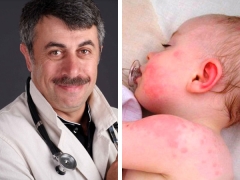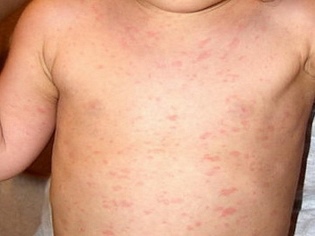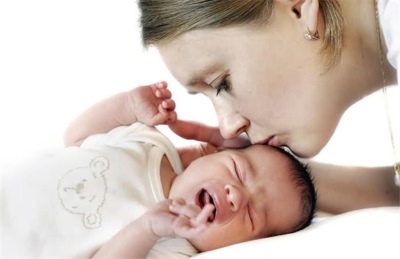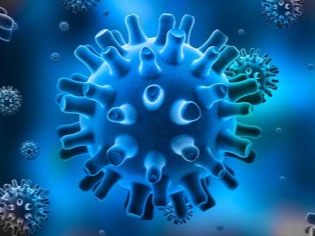Dr. Komarovsky about roseola
There are in the world such strange childhood diseases, which seem not to exist. Practically everyone is sick of them, but the majority of doctors cannot detect them and make the correct diagnosis. By the mysterious and mysterious ailments, for example, is roseola pink. Everyone has heard about it, but no one really knows anything. With the exception of Dr. Komarovsky, who shares his knowledge with parents who want to know more about the health of their own child.
About the disease
Doctors call Rozola differently - the sixth disease, sudden rash, pseudo-redness, etc. Despite the fact that the ailment is very common among the child population and is considered a unique childhood disease, it is always confused with the skin’s allergic skin reaction, then viral infection.
Causes disease herpes virus sixth type. Its carriers are most often adult family members who are not even aware of this.
The only manifestation in people of adults is chronic fatigue syndrome. After the birth of the baby, this condition is characteristic of all household members to one degree or another, and it is not accepted to go to doctors with complaints of fatigue.
At first, the child has signs of ARVI, the symptoms are quite typical: a sharp rise in heat (above 39 degrees), there may be a slight runny nose, a headache. All the symptoms of intoxication are evident - body aches, sometimes children have diarrhea or vomiting on the background of high temperature. After 3-5 days, the baby’s condition stabilizes, the temperature drops. And as soon as the parents calm down and rejoice at the cure, a strange pink rash appears all over the body, with the exception of the face and extremities.
The rash does not itch and does not itch, has a size of 3-5 mm in diameter, sometimes a pink speck at the edges can be surrounded by a white border.
Usually rash occurs 1-3 days after the "recovery" from symptoms of SARS. The rash is very similar to rubella, but any competent doctor, caused by anxious parents, immediately excludes this dangerous disease, because apart from the rash in the clinical picture there is nothing that would resemble rubella.
The rash that is most concentrated on the stomach, baby’s back, disappears just as mysteriously as it appeared, strictly on the sixth day after the onset. It is impossible to get sick with roseola for the second time, as it produces a stable lifetime immunity.
According to statistics from the World Health Organization, three out of ten babies under the age of one and a half to two years are ill with roseola. The most “dangerous” age is 9-12 months.
Than dangerous
According to Yevgeny Komarovsky, there is no particular danger in roseola itself. She passes by herself; for this, it is not necessary to give any special medication. Sudden rash usually does not give any complications. However, the initial stage of the disease, associated with high fever, is dangerous. For infants, such a high temperature is very dangerous, because it can cause cramps, respiratory arrest, irreversible destructive processes in the nervous system of the crumbs. If there is vomiting, then the baby is at risk of fairly rapid dehydration.
Treatment according to Komarovsky
Difficulties with the appointment of the correct treatment are difficulties in diagnosing the disease.Usually, looking at the pink rash, the doctor concludes that the child had a drug allergy (after all, the parents had given him several drugs when the temperature was high), prescribing antihistamines. And when the rash passes (on the sixth day), then mom and dad are sincerely convinced that the prescribed treatment helped. In fact, Komarovsky says, the rash would have passed without antiallergic pills, simply because it was time for her to disappear.
In the worst case, the doctor will diagnose rubella and prescribe the appropriate treatment.
If the doctor believes that the child has rubella, parents should definitely insist on conducting a clinical blood test, which will establish the presence of a herpetic type six virus in the child’s blood and antibodies to it.
In the worst case, the district or district doctor does not even try to understand the reasons for the appearance of the child’s rash and they immediately prescribe antibiotics, antiviral drugs and several vitamin complexes (just in case). Roseola, Komarovsky says, is a virus, it is not treated with antibiotics in principle, and antiviral drugs do not have proven efficacy at all; therefore, their use, in fact, is useless.
Adequate treatment of the herpes virus of the sixth type, according to Komarovsky, is not to shove the whole assortment of the local pharmacy into the child, but create the best conditions for a speedy recovery:
- Give antipyretic. Ibuprofen or Paracetamol is best suited for children. It should be noted that the temperature at roseol gets off very reluctantly and slowly, it may even seem that the antipyretics did not work at all.
- Give plenty of water to the child at the initial acute stage of the disease. Drinking should be at room temperature, so it will be absorbed faster. It is not necessary to give sweet or carbonated drinks, it is good if the mother makes a fruit compote of dried fruit, makes juice, makes weak tea, gives regular non-carbonated drinking water. To understand how much liquid to give the baby at a temperature, you need to multiply its weight by 30. This will be the amount of liquid in grams.
- In the room of the child should not be hot, dry and dusty. Remove all carpets and soft toys, air, moisten the air. The temperature in the room should be at the level of 18-20 degrees, and the relative humidity of the air - 50-70%. If you do not have a humidifier, you can hang wet towels around the house.
- At the time of illness do not need to overfeed the child. If there is no appetite, it cannot be fed by force. All food must be easily digestible. If there is vomiting and diarrhea, be sure to give the child oral rehydration products ("Smektu", "Regidron»).
- If the child is already actively moving and walking, during the initial stage, it is necessary to ensure him peace, bed rest will reduce energy costs, and the baby will feel better.
Quarantine events
Contagious baby with roseola is considered to be during the acute period, that is, before the onset of cutaneous manifestations of the disease. For this period it is better to protect him from communication with other children. After the appearance of the rash, the patient is no longer considered dangerous, he can walk and contact with other children.
Dr. Komarovsky will tell you about how Roseola is developing in the next video.



















